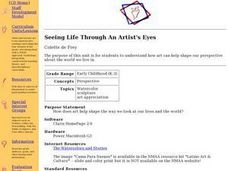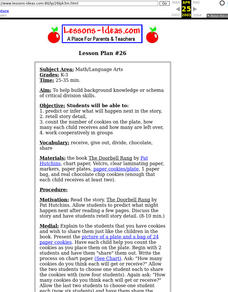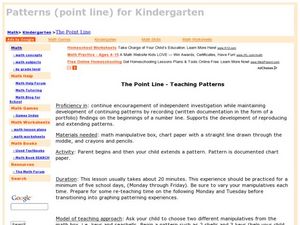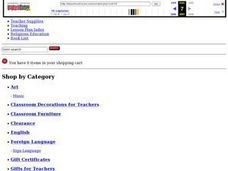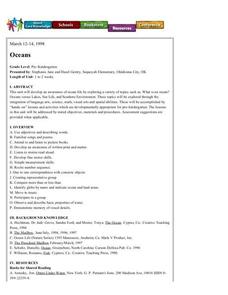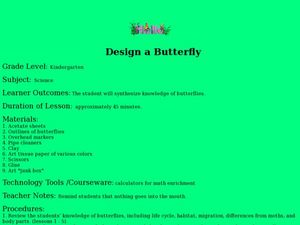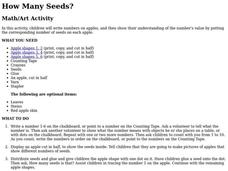Curated OER
Counting Fun with Gummi Bears
Students count the numbers one through ten out loud and show the numbers using manipulatives.
Curated OER
Philanthropic Literature: Give a cookie
Students read a book to discover the importance of sharing. They predict what will happen in the story. Students use manipulatives to model the story problem. Students follow instructions, measure ingredients, and make cookies.
Curated OER
Seeing Life Through An Artist's Eyes
Students examine how art can change the way they look at their lives. After being read a book, they discuss the importance of art in their world and what would happen if it were taken away. They create a watercolor painting and shares...
Curated OER
The Flat Stanley Project
Students read the book Flat Stanley. In this environmental stewardship lesson, students participate in earth-friendly activities based upon the book. This lesson includes ideas such as using recycled paper to make a "paper pal."
Curated OER
Lesson Plan #26
Pupils build background knowledge or schema of critical division skills by predicting or inferring what will happen next in the story, retelling story detail, and counting the number of cookies on the plate.
Curated OER
The Point Line - Teaching Patterns
Students practice extending patterns. In this patterns lesson, students demonstrate extending patterns by performing a rhythmic patter.
Curated OER
And the Number Is
Students identify the numbers 1-10 while listening to a counting song. They practice counting items using the numbers 1-10.
Curated OER
Graphs
Students listen to the book, TOPS AND BOTTOMS looking at different vegetables from the story that they have tried in class that week.
They then focus their attention on a graph called, "What is Your Favorite Vegetable?". They place a...
Curated OER
Venn Diagram
Pupils use a Venn diagram to show students' likes and dislikes of eggs and ham.
Curated OER
Sorting Lids
Young scholars practice sorting lids in different ways so that each group determines a sorting pattern. They examine how to work in groups while sharing ideas. They establish group work relationships that become apparent to the teacher...
Pennsylvania Department of Education
Seeing Doubles
Young scholars work with dominoes to recognize the number of spots on each side as they relate to addition facts. In this seeing doubles lesson, students make triangle shaped flash cards for the double facts. Young scholars represent the...
Pennsylvania Department of Education
Multiple Patterns
Students explore patterns that involve doubling numbers. In this multiple patterns lesson, students use objects to explore these patterns while recording them using a table. Students recognize even and odd number patterns while applying...
Curated OER
Build Your Own Bug
Students create a unique bug. In this lesson about bugs, students use their imagination to develop a new kind of bug. Students use construction paper, scissors, glue, and crayons to make their bug. Students explore the different parts of...
Curated OER
How Does Your KinderGarden Grow
Students find forecast and graph weather by using WeatherBug site, create flower books by using Wiggleworks, and plant radish seeds both on KidPix and in class garden.
Curated OER
Oceans
Students become aware of the differences between ocean water and lake water by smelling, tasting and seeing. They distinguish between land and bodies of water on a globe and gain increased awareness of oceans and life.
Curated OER
Pondering the Perfect Pet
Cute, playful, mischievous pets will capture the attention of even your most reluctant learners.
Curated OER
Design a Butterfly
Students access prior knowledge of butterflies. In this butterfly lesson, students create butterflies and compare and contrast their butterflies. Students describe the various body parts.
Curated OER
Painted Story Quilt
Emmulate some of Faith Ringgolds famous painted story quilts in your classroom. Have your class choose a story or you choose one for the whole class to portray. They will select their favorite scene to paint onto their story quilt. What...
Curated OER
Do Touch!
Students explore the sense of touch. They investigate unknown solids using the sense of touch. Pupils use their senses of touch to match feely gloves. Students explore body parts, by tracing their hands and feet on paper. They create a...
Curated OER
The Drum
Students complete a variety of activities related to the folktale from India, "The Drum." They listen to the story and answer comprehension questions, construct a coffee can drum, and complete a phonics and matching worksheet.
Curated OER
Caterpillar Habit
Students watch a caterpillar change and become a butterfly. In this lesson about the life cycle of a caterpillar and a butterfly, students prepare and maintain the habitat of the caterpillar. Students observe the stages of the...
Curated OER
How Many Seeds?
Students write numbers on apple shapes, and then show their understanding of the number's value by putting the corresponding number of seeds on each apple.
Curated OER
Moth or Butterfly
Students categorize butterflies and moths by identifying the unique characteristics of the two different species. For this classifying lesson, students discuss their prior knowledge about these insects before categorizing the two.




